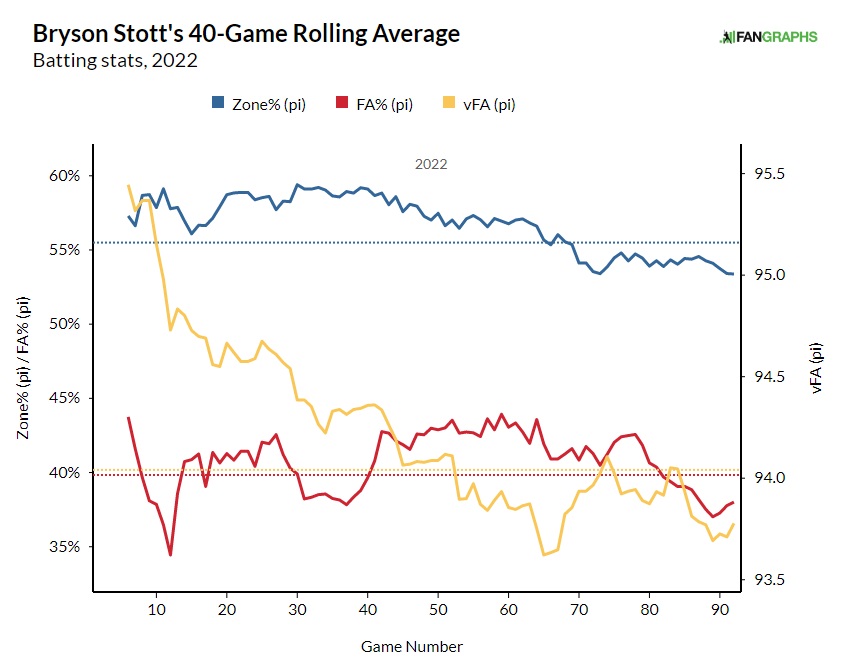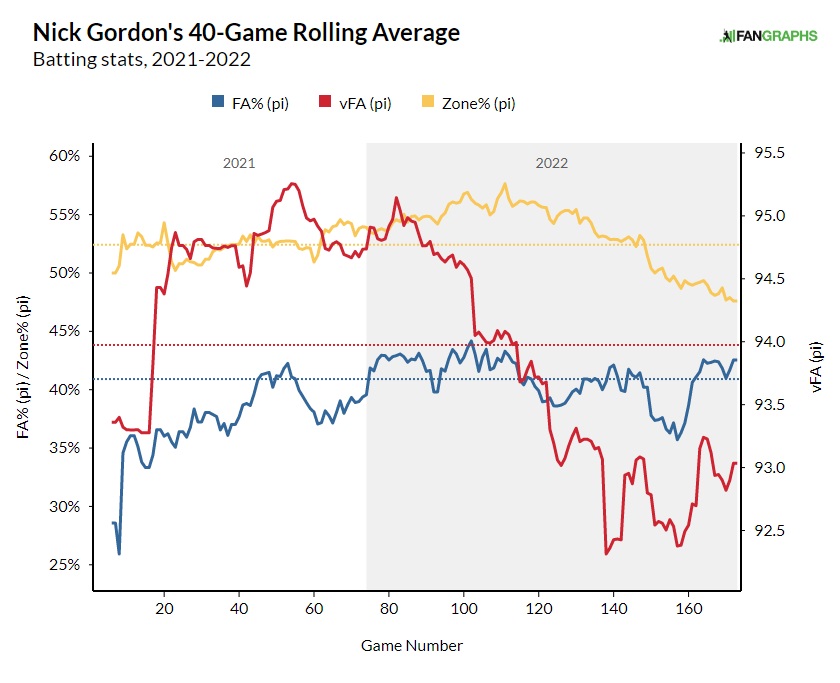Hitters Who Get “No Respect”
Recently I wrote up Myles Straw, I found out the league was throwing him the most fastballs (60%, league at 49%) and the most pitches in the strike zone (57%, league at 50%). Additionally, slow fastball pitchers weren’t afraid of him with the 13th lowest fastball velocity against. I went one step further and looked to see how far outfielders were playing him and he was one of the shallowest played guys. He was just getting no respect.
As much as a list of non-respected players seems like a topic perfect for Jeff Sullivan if he was still around (he’s still alive, just working for a team!), I am hoping there could be a fantasy implication. MLB teams have a ton more computer-generated information on hitters coming through the minors like pitches seen and all the detailed StatCast metrics. On top of this information, scouts can provide another level of needed detail. When a hitter gets to the majors, there is a book on them. My goal is to see if that book can be immediately spotted by seeing if opposing pitchers and fielders “Respect” that hitter. Here is my first stab and hope to keep improving over the rest of the season.
Mathy Stuff
Feel free to jump to the ranking section if you don’t want the details behind the rankings.
I started with all the hitters with at least 10 PA and collected the following four metrics.
- Average fastball velocity seen. Pitchers with slow fastballs don’t have an issue throwing to these batters. Also, teams don’t bring in their elite bullpen arms because these batters can’t make hard contact.
- Fastball Percentage. Major league batters can hit fastballs and teams don’t mind if these batters put the ball in play because it’s either an out or just a single.
- Zone Percentage. Again, pitchers will just fill the zone with pitches (e.g. slow fastballs) and quickly get the at-bat over with.
- Average center field distance. Teams are reading their little positioning cards and move in when these batters are up to bat. I limited the distance to the last pitch of the plate appearance so there is only one value for each plate appearance.
For each of the four factors, I found the sample’s median value and standard deviation and calculated the Z-score. Then I added the four Z-scores together to get an overall value. I weighted the four z-scores the same for now. I worry that I’m giving the pitchers too much weight, so I could change this mix in the future. Finally, I put the values on a percentage Respect scale. Hitters who are closer to 0% are getting no respect.
The goal was to find hitters who are getting no respect, not so much those getting respect. At the end of that list is populated with guys who swing at breaking balls out of the strike zone (e.g. Javier Baez). One way I can try to improve the rankings is to get the values working on both ends. For now, I will just focus on weak hitters.
Rankings
Here are the ten hitters (min 100 PA) who are getting the least amount of respect.
| Name | PA | Zone% | velo | FBp | CF distaance | Respect% |
|---|---|---|---|---|---|---|
| David Fletcher | 124 | 56.4% | 93.5 | 57.2% | 307 | 1% |
| Myles Straw | 459 | 56.2% | 93.3 | 60.4% | 313 | 2% |
| Steven Kwan | 451 | 54.2% | 93.2 | 58.9% | 312 | 2% |
| Ernie Clement | 158 | 54.1% | 93.1 | 56.2% | 313 | 3% |
| Nick Madrigal | 176 | 51.1% | 93.3 | 57.6% | 311 | 3% |
| Tony Kemp | 416 | 52.6% | 93.3 | 58.3% | 315 | 4% |
| Luke Maile | 148 | 52.5% | 92.6 | 58.3% | 320 | 4% |
| Luis Guillorme | 289 | 54.1% | 93.5 | 56.7% | 315 | 4% |
| Mike Brosseau | 135 | 54.4% | 93.1 | 56.4% | 319 | 5% |
| Bryson Stott | 331 | 54.6% | 93.5 | 56.2% | 317 | 5% |
| League Average | 50.4% | 93.6 | 48.9% | 322 |
There are absolutely no surprises on that list and the entire list can be found here.
With the rankings having passed the initial sniff test, here are some young hitters who stick out for getting no respect. In the end, I find more questions than answers.
Bryson Stott (5% Respect)
It was understandable that teams weren’t giving him much respect because in the 78 PA before June 1st, he had nine hits and two went for extra bases (.123/.179/.151). It was ugly. While hasn’t been great since that point (.228/.288/.360), he does have 8 HR and 7 SB in 337 PA. Slowly the league is starting to respect him a little bit more.

Most of the changes have come in the last 20 games with his Zone% and fastballs seen having dropped.
With just my first profile, two ideas should be addressed.
- Monthly time frames need to be available to help find trends.
- The above graph provides three of the four factors and provides some trend analysis.
Luis González (8% Respect)
I was surprised to see Gonzalez so low. In 288 PA, he was hitting .260/.330/.378 with 4 HR. His 109.7 MaxEV is in the 60% percentile and he wasn’t putting a ton of balls on the ground (44% GB%). Teams weren’t buying it.
Digging a little deeper, the MaxEV was the only StatCast power metric over a 15% percentile.

While I’ve leaned toward MaxEV, I might need to reevaluate. I’ve always operated that teams have so much more knowledge compared to me, so I should find out how well any publicly available metrics correlate with the No Respect value.
Nick Gordon (10% Respect)
There are a ton of narratives around Gordon having no power. The first is that he is the brother of Dee Strange-Gordon and his .074 ISO. The second is that Nick Gordon has dealt with a stomach ailment that has limited the amount of muscle he can add.
Gordon missed the entire 2020 season, as COVID-19 sidelined him for most of the summer and chronic gastritis made it difficult to keep weight on once he was finally feeling better. At one point the 6-foot Gordon weighed just 153 pounds. Doctors struggled to find solutions, and through the combination of diet and medication, Gordon was eventually able to start eating normally again.
He quickly put on more than 20 pounds last year, and this offseason, relieved to be able to eat and work out without complications, Gordon focused on adding strength.
Nick didn’t start out the season that great but has continued to improve each month.
Month: OPS
Apr: .621
May: .640
Jun: .785
Jul: .793
Aug: .847
Looking at the same graphs as Stott’s, the results are mixed.

Monthly data is needed to get a full picture.
Joey Bart (10% Respect)
At one time, Bart was one of the game’s top prospects but just hasn’t lived up to the hype. The main reason for his struggles is a career 37% K%. The Giants gave him another chance but in early June (45% K% and .596 OPS), he got demoted back to AAA. Since returning in early July, he’s hit .292/.330/.491 with 6 HR and just a 30% K%.
Opposing teams aren’t buying any kind of a turnaround since they know that most likely outcome of any at-bat is a strikeout.
P.J. Higgins (11% Respect)
Higgins has 6 HR and a .203 ISO in just 143 PA. He’s on a 24 HR pace with an ISO within a few points of Julio Rodriguez (89% Respect), Will Smith (57%), and Adolis Garcia (88%). So why the disconnect?
Again, it comes down to the StatCast numbers. Unlike Gonzalez, Higgins has a low 104 mph MaxEV (16% percentile) and an xISO of just .093. It seems like teams aren’t treating him like a normal .200 ISO hitter because they don’t see him as one.
Jeff, one of the authors of the fantasy baseball guide,The Process, writes for RotoGraphs, The Hardball Times, Rotowire, Baseball America, and BaseballHQ. He has been nominated for two SABR Analytics Research Award for Contemporary Analysis and won it in 2013 in tandem with Bill Petti. He has won four FSWA Awards including on for his Mining the News series. He's won Tout Wars three times, LABR twice, and got his first NFBC Main Event win in 2021. Follow him on Twitter @jeffwzimmerman.
Love your work overall.You are Top Drawer.But,this article has no conclusions. That’s what you desired?
“So, to conclude, this has been a study of five batters who are getting no respect.” – hope this helps
Downvoted for the directness, I suppose, but it’s a fair question. This is information, but what do we think it says re: a player’s fantasy value? If a power hitter gets no respect, does that mean he’s a buying opportunity? Or does it just mean the league hasn’t figured him out yet? Do we care where a player exists on this list at all? Or should we start to care when a player begins to move on this list? etc…
Seems like he directly addressed that in the article:
Showing how he approaches a topic of interest and that sometimes it doesn’t produce any useful conclusions has some value in and of itself, I think.